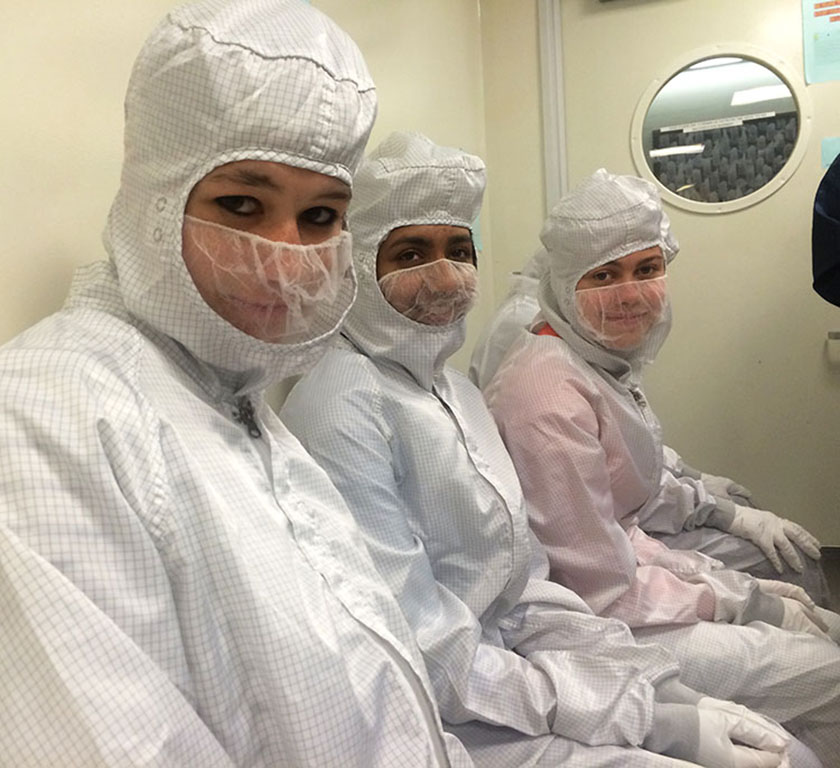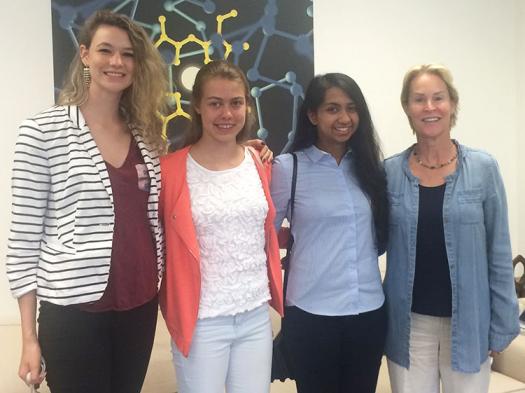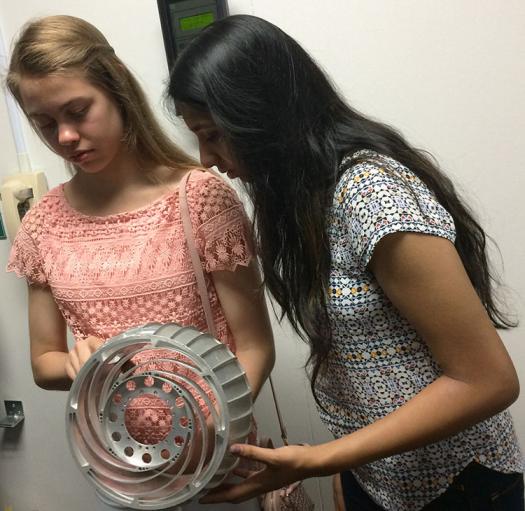Before STEM ‘I called it exploring’

Tiasha Joardar is an Intel ISEF 2016 finalist who visited NASA’s Jet Propulsion Laboratory and CalTech on an Intel ISEF special award trip to California. She went with two other 2016 Intel ISEF finalists — Nicky Wojtania and Camille Yoke.
We talked to Tiasha about her solar power research, how her Intel ISEF experience fed her passion for a STEM career, and wearing bunny suits at Caltech.
ON MEETING WOMEN IN STEM: One of my favorite parts of the entire experience was talking to Frances Arnold, who was recently awarded the Millennium Technology Prize for her work in biology and directed evolution. It was inspiring to be able to meet with such a successful scientist who also happened to be a woman.
The fact that all three of us on the summer trip are women is very telling of a transforming world and a shrinking gender gap in science.
The fact that all three of us on the summer trip (Nicky, Camille, and I) are women is very telling of a transforming world and a shrinking gender gap in science, which just made speaking to Mrs. Arnold that much more reaffirming.
ON THE “MIND-BLOWING” VISIT TO JPL AND CALTECH: The trip to JPL and Caltech was mind-blowing. I’m incredibly grateful to Intel and the Society for Science & the Public for providing this amazing opportunity to learn more than I thought was possible in the span of two days.
We toured CalTech first and spoke with people working on various projects. Our first stop was the Resnick Institute for Sustainability, where we learned about the team’s research in working towards a more sustainable future.
Help others into science fairs so they too have mind-blowing experiences. Join the Society today!
The Joint Center for Artificial Photosynthesis focuses on the design of efficient solar-to-fuel generators that use water and carbon dioxide. I felt like I had a special connection with this lab specifically because my project also has a lot to do with energy sustainability.
Next, the Shapiro Lab gave us an introduction into his research on ultrasonic modulation of biological systems. He taught us about genetically encoded and imaging agents for ultrasound based on gas vesicles, which use their buoyant microbes to act as reporter agents in cell-based applications.
At JPL we went on nine different tours. We explored the Curiosity Mars TestBed, where they have the Mars Yard, which is basically an imitation of the surface of Mars; the Digital Image Animation Lab, where they use 3D imaging to simulate the experience of being in space; and other amazing labs.
Before I knew it as science, technology, engineering, and math, I just called it ‘exploring.’
One of my favorite tours was the Solar Cell Energy Systems. We learned about efforts in making solar cells more efficient by using multi-junction structures, which is something I’ve encountered in my research in the area of solar panels. We discussed methods of solar cell efficiency for different applications; whereas the systems I worked on adapting were geared for commercial or residential use, their research was directed for use in outer space.
It was incredible to see how everyone we spoke to took different paths, but eventually were united through their research. That was a common thread — these people who were making their names and discovering new things in the world of science and engineering all started with research.

ON WEARING BUNNY SUITS: The bunny suits were for our tour through the Nanoscience Institute Clean Room at Caltech. We were able to catch a glimpse of the different nanofabrication projects. We got a cool look at their different microscopy methods and tools used across different kinds of experiments. Matt showed us, step by step, how to create and synthesize different structures with the devices they had.
It was inspiring to meet such a successful scientist who also happened to be a woman.
CREATING SMART SOLAR POWER: In my project, I took a step towards achieving cost parity between solar energy and fossil fuels. I developed smart solar that is able to produce significantly more energy than a conventional cell by automatically regulating its own temperature under varying atmospheric conditions.
I created a feedback loop between a PV solar cell and a thermoelectric cooler (TEC). The main idea was to use a fraction of the solar cell’s own power to drive the TECs. The resultant cooling effect recovered significantly more power than what was diverted to the TEC. My smart solar cell was able to produce 10.25 percent more energy compared to a conventional solar cell.
HOW DID YOU FIRST BECOME INTERESTED IN STEM: I’ve been involved in STEM since I was a little kid, before I knew it as science, technology, engineering, and math and just called it “exploring.”
The trip to JPL and Caltech was mind-blowing.
My parents had a lot to do with my interest in science and technology. My dad’s idea of a Christmas present was a circuit board that I could use to light up light bulbs, create a working radio, alarm, and more. My high school, Plano West Senior High, also places a strong emphasis on science and math. I surround myself with people with similar interests and completed a summer internship in the mechanical engineering department at the University of Texas at Dallas.

NEXT STEPS: I will attend the University of Texas at Austin in the fall. I’m continuing my research from my science fair project. Some of that work includes placing the thermoelectric coolers in a cascaded structure in order to decrease the temperature difference across each one, making the whole system more efficient.
MOST MEMORABLE INTEL ISEF EXPERIENCE: At public viewing day, I had the chance to speak to a lot of children who were genuinely interested in science. It was inspiring to see how curious and open-minded they were and a pleasure to be able to show them my research.
Science is a collaborative experience.
I’d be motivated to pursue science regardless of awards or recognition, because of the joy I get from learning new things through scientific exploration. However, my experience at Intel ISEF did reaffirm that science is a collaborative experience, and that you can always stand to learn something new from your peers.
I had the time of my life talking to others at the fair and with judges. They gave me countless pieces of feedback and advice that I’ve implemented in my research since.
I’m extremely grateful for the monetary rewards from the 1st place and Best of Category and IEEE’s special award. I will use the money to continue my pursuit of scientific research. I’m incredibly thankful for the new opportunities it has opened up for me. Thank you to Intel and the Society, and to my teachers and parents who continue to support and encourage me to pursue what I love.
ADVICE FOR STEM STUDENTS: There’s no greater feeling in the world than getting your desired results out of an experiment or having a research project conclude in your favor. But the failures you experience can be just as influential.
The failures you experience can be just as influential as getting your desired results out of an experiment.
In my experience, when things go wrong, I learn far more than I ever expected to, which helps me push my project along further.


